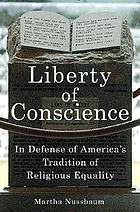I earlier published a review of Professor Nussbaum's The New Religious Intolerance: Overcoming the Politics of Fear in an Anxious Age. That book skims through arguments she fleshed out in greater detail and with different historical examples in Liberty of Conscience.
I want to reproduce a few passages which described some aspects of U.S. history which I'd never heard.
For [Francis] Bellamy, the Pledge of Allegiance was crucial both because it affirmed the moral basis for nationhood in a world of greed and also--and inseparable--because it affirmed the values of a Protestant, Northern and Western European America against the subversive values vaguely associated with new immigrants from Southern and Eastern Europe, and their Catholic faith. For that reason it is not all together surprising that the pledge itself expresses liberal ideals, while the ritual of compulsory school recitation that Bellamy associated with it expresses a less lofty set of values, creating an imposed order into which all new customers would be inserted their peril. P 201
Martha Nussbaum. Liberty of Conscience, p202. Read troubling history of #USA Pledge of Allegiance & flag salute pic.twitter.com/ecyCIG3RKh
— Ayman Hossam Fadel (@aymanfadel) May 4, 2015
— Ayman Hossam Fadel (@aymanfadel) May 4, 2015
16yr old Ellery Schempp read from the Quran for mandatory school prayer, leading to famous 1963 #SCOTUS ruling #Islam pic.twitter.com/7CS7gvXvoW
— Ayman Hossam Fadel (@aymanfadel) May 6, 2015Just to be clear, I don't think Ellery was "called to the studio" http://t.co/fGr73eQdEh
— Ayman Hossam Fadel (@aymanfadel) May 6, 2015Check out other blog entries tagged "Religious Freedom."

